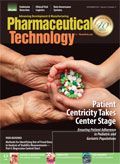ODTs Dissolve Drug Administration Challenges
Ralph Gosden, head of product development at Catalent’s Swindon, United Kingdom site, explains the opportunities of orally disintegrating tablets as a patient-centric dosage form.
The advantages of orally disintegrating tablets (ODTs) as a patient-centric dosage form are well recognized. “Because of their convenience and ease of administration, ODTs are ideal for pediatric, geriatric, and psychiatric patients,” says Ralph Gosden, head of product development at Catalent’s Swindon, United Kingdom site. “They dissolve in the mouth without water, thereby addressing the problem of difficulty in swallowing. It has been reported that 25–45% of children have swallowing difficulties and 30–40% of elderly institutionalized patients suffer from dysphagia.” He adds that ODT formulations reduce the overall cost of care, citing a study that showed children receiving orally disintegrating ondansetron tablets for the treatment of gastroenteritis had less vomiting, increased oral hydration, and reduced need for intravenous hydration (1). ODTs demonstrated economic value through cost savings from reduced length of hospital stay. The authors of the study noted that the ODT was easy to administer, had few side effects, and was safe and effective, making it a useful therapy in the emergency department for children with vomiting and mild-to-moderate dehydration as a result of gastroenteritis (1).
According to Gosden, speed is an important parameter with ODTs. “The requirements for an ODT is to have fast dispersion rates,” he explains. “Rapid dissolution enables effective buccal and sublingual delivery, which may enable pre-gastric absorption, rapid onset of action, and reduced side effects by avoidance of food effects and first pass metabolism.” He adds that other desired critical quality attributes of ODTs include appearance, palatability, potency, physical/chemical stability, and physical strength to withstand packaging, shipping, and patient handling.
Gosden, however, notes that drawbacks of ODTs include the requirements for taste masking and the drug loading capacity. Catalent’s Zydis Ultra technology was developed to address those limitations, he says. Zydis Ultra is the same basic formulation as Catalent’s Zydis ODT, which is a lyophilized oral solid-dosage form that dissolves in the mouth in less than three seconds. A lyophilization process is used to make the ODT. The API is formulated into a solution or suspension, which is then filled into blisters and passed through a specially designed cryogenic freezing process to control the size of the ice crystals and subsequent pore formation during freeze drying. After the drying step, the blisters are sealed to protect the product.
Gosden explains that Zydis Ultra includes a dry coating process for taste masking. “Micronized polymer agglomerates, through the action of acoustic vibration and particle–particle interaction, are used to coat the host API. Particle collisions deform the deposited polymer to create a continuous coating layer,” he says. “No solvent is involved in this process; it is a completely dry process. It has the ability to coat small particles of approximately 100 µm and the potential for much higher API potency in the coated material.”
Zydis Bio offers opportunities for the sublingual or buccal delivery of biologics, such as peptides, proteins, allergens, and vaccines in an ODT formulation, Gosden highlights. He adds that there are no extreme pH exposure or proteases in the oral cavity and this route avoids the harsh environment of the gastrointestinal tract. “For vaccines, Zydis Bio offers the potential to eliminate cold-chain storage. Zydis vaccines are suitable for mass immunization programs and emergency response,” says Gosden. For stability, he explains, Zydis Bio uses a lyophilization process with low processing temperatures, and there are formulation options to optimize in-process stability such as through matrix component selection or pH adjustment. He adds that the dried product has low water activity to ensure long-term stability. Acceptable room temperature storage has been demonstrated for multiple peptide and protein compounds, according to Gosden.
Catalent’s Zydis Bio technology enabled Danish pharmaceutical company ALK-Abelló A/S to successfully launch Grazax as a patient-friendly allergen immunotherapy for the treatment of grass pollen-induced allergic rhinitis (2). Grazax is a registered trademark of ALK-Abelló A/S. Patients previously had to make monthly visits to the clinic for their subcutaneous injections. The convenience of being able to administer a daily sublingual dose of the medication at home improved patient experience and increased patient adherence.
References
- S.B. Freedman et al., New Engl J Med 354 (16) 1698-1705 (2006).
- Catalent, Case Study-Zydis Bio Technology, Grazax & Grastek: Revolutionizing Allergy Therapy,www.catalent.com, accessed Sept. 28, 2017.
Article Details
Pharmaceutical Technology
Vol. 41, No. 11
November 2017
Page: 18
Citation
When referring to this article, please cite it as A. Siew, “ODTs Dissolve Drug Administration Challenges," Pharmaceutical Technology 41 (11) 18 (2017).

Drug Solutions Podcast: A Closer Look at mRNA in Oncology and Vaccines
April 30th 2024In this episode fo the Drug Solutions Podcast, etherna’s vice-president of Technology and Innovation, Stefaan De Koker, discusses the merits and challenges of using mRNA as the foundation for therapeutics in oncology as well as for vaccines.
Drug Solutions Podcast: Applying Appropriate Analytics to Drug Development
March 26th 2024In this episode of the Drug Solutions Podcast, Jan Bekker, Vice President of Business Development, Commercial and Technical Operations at BioCina, discusses the latest analytical tools and their applications in the drug development market.
INTERPHEX 2025: Use of Walk-In Chambers for Bio/Pharma Development and Manufacturing
April 2nd 2025Sitting down with the PharmTech Group at INTERPHEX 2025, Christopher Murphy, director of Global Business Development and Service Customer Support at Environmental Specialties, discusses the design and critical role of walk-in chambers in the bio/pharmaceutical industry.